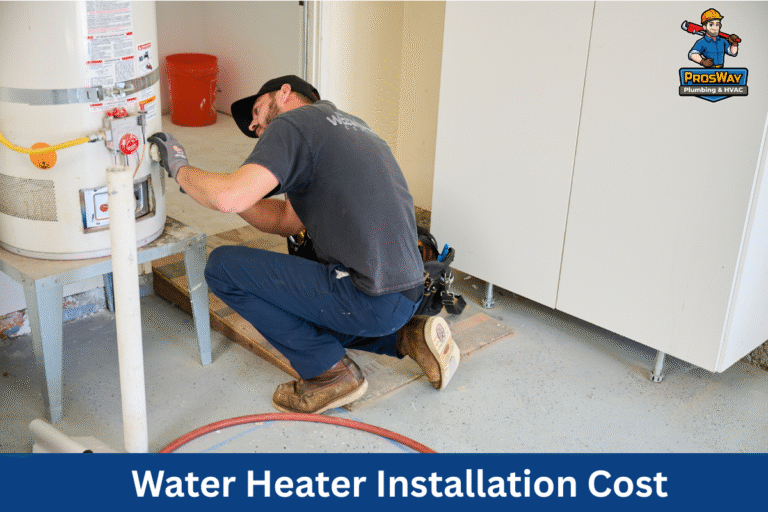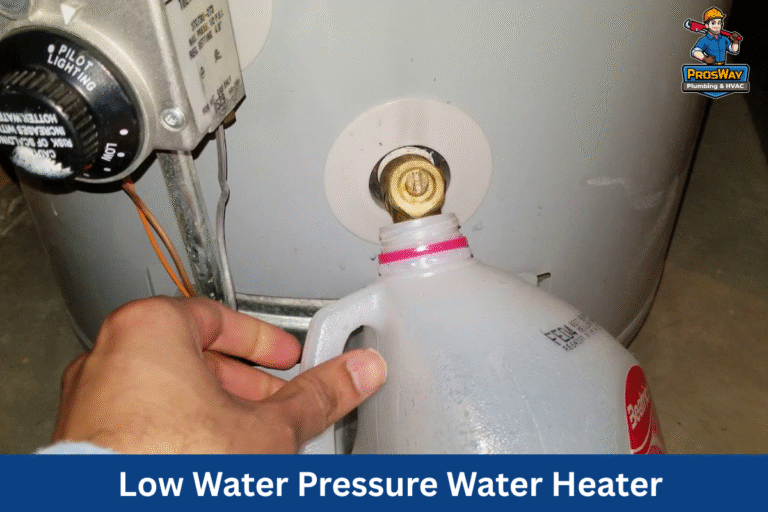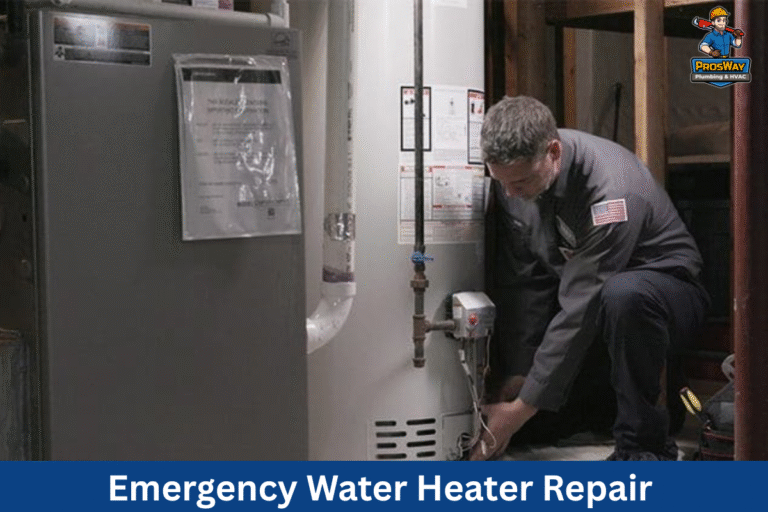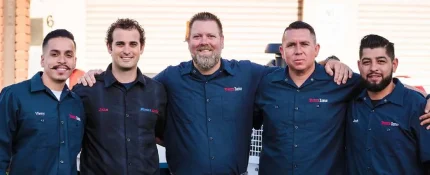In this article, we explain common sewer line problems that you might be able to fix yourself. Homeowners in Northern New Jersey dealing with issues such as water damage, blockage, and drainage failures can sometimes repair minor sewer problems with a bit of guidance.
At ProsWay Plumbing & HVAC, we understand the problems like debris buildup, pipe corrosion, and root intrusion, and we go into the safety requirements and DIY sewer line repair techniques. We also explain step-by-step repair techniques along with preventative methods to avoid recurring issues.
What sewer line issues can homeowners fix?
The sewer line is a critical component of your home’s plumbing system, and problems can range from minor clogs to significant damage. The first step is recognizing the signs of sewer line distress.
Unpleasant odors, slow drains, and sewage backups can indicate that your sewer line is failing. In many cases, these issues can be traced back to blockages caused by tree roots, accumulated debris, or corrosion-related pipe deterioration.
For example, roots may start to invade the sewer line, leading to cracks in the pipe. Additionally, old cast iron sewer lines can corrode over time, leading to leaks and water damage in your home.
Recognizing these issues early is crucial. Homeowners should inspect external cleanouts and monitor drainage in sinks, toilets, and bathtubs. Sometimes, a simple visual assessment or a simple test of water flow from different fixtures can reveal irregularities in pressure.
Using home sewer inspection cameras, which have become more accessible, you can get a clear view of potential pipe damage. These cameras help diagnose the severity of the root intrusions or pipe cracks.
What Are Common Signs That Call for DIY Sewer Line Repair Techniques?
Another problem that might be amenable to DIY sewer line repair techniques is a blocked sewer line from debris. Blocked sewer lines can cause unpleasant odors and backups. The blockage may occur due to factors such as improper disposal of non-biodegradable items.
Minor leaks in PVC or ABS pipes can sometimes be sealed with pipe clamps or epoxy, if the damage is not too extensive. For further guidance, consider reading to clean your sewer system properly.
It’s important to note that while many of these problems start small, they can quickly develop into major issues if ignored. In such cases, DIY fixes may only provide a temporary solution.
Always monitor the repair, and if the problem persists or worsens, call in a professional plumber for further evaluation. Check out this video, EASIEST Way To Clear A Sewer Blockage_ This Should Be In Your Toolbox.
The difference between minor and major damage is essential in deciding whether a repair is manageable on your own. Minor issues, like small leaks or early signs of root intrusion, can sometimes be handled with basic tools.
What Tools and Safety Steps Are Needed for DIY Sewer Line Repair Techniques?
Before you start a DIY sewer line repair project, ensuring you have the right tools and are following necessary safety precautions is crucial. Working with sewer systems is potentially hazardous due to the toxic and corrosive nature of the waste.
For basic repairs, you need a standard toolkit that includes hand tools like wrenches, pliers, and screwdrivers, along with a heavy-duty pipe cutter. In addition, you should invest in specialized tools such as drain augers and hydro jetting equipment.
These devices help clear debris from the sewer line and enhance water pressure to dislodge larger blockages. Electrical drain cleaners may also work, but these are often a temporary solution.
Personal protective equipment is equally important. Always wear waterproof gloves, safety goggles, and a protective mask. Coveralls or disposable plastic suits can shield your skin from contaminants.
Since sewer repairs often involve dealing with foul odors and hazardous bacteria, having proper ventilation or using a respirator is advisable when working in enclosed spaces.
For tasks requiring substantial pipe cutting or root removal, you might need specialized equipment like trenchless repair kits or even renting a small excavator if you plan on uncovering buried pipes.
However, renting heavy equipment should only be attempted if you are confident in your skills and understand the local utility line locations before digging. Accidental damage to underground electric cables or water lines can cause extensive damage and lead to severe safety hazards.
Before beginning any repair, locate your home’s main sewer cleanout and trace the sewer line as accurately as possible. This step will help reduce the likelihood of accidental damage to adjacent utilities.
What Are the Right Steps for Fixing Sewer Line Issues Yourself?

We will guide you through a series of techniques, including clearing clogs, patching small leaks, applying epoxy lining on cracked pipes, and replacing damaged sections in accessible PVC or ABS pipes.
A Step-by-Step Guide
The first step in most repairs is to clear clogs. Start with simple methods like using a drain auger. An auger is a flexible metal cable that you push through the pipe to dislodge blockages such as debris, grease, or small objects.
In some cases, hydro jetting—a process that uses high-pressure water to flush away accumulated sediments—can be highly effective. This method is especially useful if the blockage is due to a buildup.
Next, for minor leaks or pinhole cracks, you can apply pipe patches and clamps. Modern clamps designed for sewer pipe repair are made to handle the pressure of constant water flow and can create an effective seal over small cracks.
It’s important to clean the area thoroughly with a degreaser before applying the patch to ensure a tight bond. After the clamp is in place, monitor the area to ensure the leak has stopped. If the damage involves a cracked or deteriorating sewer line, using an epoxy pipe lining can be a long-term solution.
Epoxy lining involves coating the pipe’s interior with a resin that hardens to form a strong, durable layer. This process reinforces the existing pipe. The technique works best on pipes that are not structurally damaged beyond repair.
The Importance of Carefulness
Application requires careful measurement and precision to ensure the liner adheres correctly, and you may need to follow for curing times. In some scenarios, replacing a damaged section of your sewer line might be the best solution.
Accessible sections of PVC or ABS pipes can be cut out and replaced with new pieces. This method necessitates a careful measurement of the damaged section, proper cutting of the old pipe, and precise fitting of the new segment with the appropriate couplings.
Below is a summarized table of various techniques and their primary benefits:
| Repair Technique | Primary Benefit | Typical Tools Used | Example Scenario |
|---|---|---|---|
| Drain Augering | Removes blockages efficiently | Drain auger, wrench | Clearing a clog caused by grease or debris |
| Hydro Jetting | Flushes away buildup with high-pressure water | Hydro jetter | Removing stubborn sediment accumulation |
| Pipe Patching and Clamps | Seals small leaks and cracks effectively | Patch clamp, cleaning supplies | Repairing pinhole leaks in aging cast iron pipes |
| Epoxy Pipe Lining | Reinforces and seals internal pipe surfaces | Epoxy resin kit | Treating cracked PVC or ABS pipes |
| Pipe Replacement | Replaces irreparable damaged sections | Pipe cutter, solvent cement | Replacing a corroded section of the sewer line |
| Chemical Root Control | Prevents further root intrusion and growth | Root control chemical, sprayer | Inhibiting roots from invading the surrounding trees |
Why Should Homeowners Prioritize Preventative Sewer Line Maintenance?

Once you have repaired your sewer line, ongoing maintenance is key to preventing future issues. Preventive maintenance reduces the likelihood of costly repairs later.
Regular cleaning and inspection schedules, proper disposal practices, and mindful landscaping can all play a part in keeping your sewer line in optimal condition.
A good preventive maintenance schedule starts with regular cleaning. Homeowners should establish an annual or biannual schedule for sewer line cleaning to remove buildup from debris, grease, or sediment that can accumulate over time.
Professional drain cleaning services are available, but with proper tools like a manual drain auger or a hydro jetter, you can perform maintenance on your own.
Safe disposal practices are also critical. Avoid flushing non-biodegradable items, oil, or grease down the drain as these can contribute to the buildup within the pipes. Instead, dispose of them separately and consider using drain-safe products that minimize residue.
Keeping a detailed record of any repairs and maintenance activities is beneficial. Note the date of any intervention, the materials used, and the performance after the repair.
Preventative measures extend beyond the physical maintenance of the sewer line. It is wise to consider the long-term health of your plumbing system by having periodic professional inspections. Below is a detailed list of preventative maintenance practices with explanations:
Regular Sewer Line Cleaning
Schedule periodic cleaning sessions using either professional services or DIY techniques like hydro jetting to flush out grease, sediment, and debris.
Regular cleaning prevents buildup that can lead to clogs and minimizes the risk of major blockages. It also maintains the optimum flow within the sewer line, reducing pressure and strain on the system.
Safe Disposal Practices
Avoid disposing of items such as oil, grease, wipes, or non-biodegradable items down the drain. Instead, dispose of them through proper waste channels.
This practice reduces the introduction of harmful substances into the sewer line, thereby reducing contaminants that may lead to blockages or chemical reactions that weaken pipe materials.
Strategic Landscaping
Plant trees and shrubs away from the sewer line to avoid root intrusion. Roots are naturally attracted to moisture and can penetrate small cracks, gradually expanding and causing severe damage. Selecting shallow-rooted plants around the sewer area helps decrease the risk and ensures the longevity of the piping system.
Regular Inspection of the Cleanout
Examine your sewer cleanout periodically for signs of slow drainage, standing water, or damage. Early detection of issues at the cleanout can lead to prompt intervention, keeping problems from developing into more extensive damage.
Regular inspections provide a clear idea of the overall health of your sewer system and offer opportunities to address minor issues before they become significant.
Use of Enzyme-Based Cleaners
Incorporate an enzyme-based drain into your regular maintenance routine. These cleaners help break down organic waste naturally, reducing buildup in the sewer line. This method is environmentally friendly and minimizes the risk of chemical-induced corrosion, ensuring that the pipes remain intact and functioning efficiently.
When Should You Avoid DIY Sewer Line Repair and Call Professionals?

DIY sewer line repair is attractive for its convenience and cost savings. However, certain tasks may be too complex or dangerous for a homeowner to tackle alone. While simple fixes can be managed with basic tools, knowing when to call a professional is crucial for your safety.
If the damage to your sewer line exceeds minor clogs or small leaks, you risk creating further issues by attempting DIY sewer repair techniques. Major cracks, extensive corrosion, or significant blockages due to heavy root intrusion often require specialized equipment and expertise.
In these cases, a professional plumber can provide a more permanent solution, such as trenchless sewer repair or full pipe replacement. Professionals have access to inspection cameras and advanced diagnostic tools that ensure a precise assessment of the damage.
Another factor that highlights the need for professional assistance is the complexity of local regulations and municipal codes. Professional plumbing companies, such as ProsWay Plumbing & HVAC, ensure that their work is compliant with these regulations.
Here is a checklist you might consider to assess whether a repair can be tackled on your own or if professional help is needed:
- Scope of Damage: If visual evidence or inspection camera results show widespread deterioration or large cracks, this is likely beyond simple DIY sewer repair techniques.
- Recurrence of Issues: A repair that temporarily improves drainage but quickly reoccurs indicates deeper issues that necessitate professional intervention.
- Complexity of the Task: Advanced repairs, such as those involving colonized roots or significant structural damage, are best handled by trained professionals.
- Safety Concerns: If the repair involves heavy machinery, underground excavation, or exposure to hazardous waste, calling a professional is the safer route.
- Regulatory Compliance: For repairs that require permits and adherence to local building codes, a licensed plumber ensures that the work meets all regulatory requirements.
What Should Homeowners Know About Local Sewer Line Repair Regulations?
When planning any repair on your sewer line, understanding and complying with local regulations is essential.
Municipal Codes And Standards
In Northern New Jersey, municipal codes and permit requirements play a significant role in ensuring that repairs are safe, hygienic, and sustainable.
Navigating these regulations might seem complex, but it is a critical part of the repair process. It is important to check if you need a permit before you start any sewer repair work. Many localities require permits for any invasive work.
Next, it is critical to adhere to municipal codes and standards. These codes dictate acceptable practices, from the type of materials used for repair (like PVC, ABS, or cast iron pipe specifications) to safety measures during excavation.
Codes may also outline how to dispose of contaminated materials and what documentation must be kept on file. Often, municipalities require that this waste be taken to a licensed facility rather than being discarded in ordinary trash.
The exact location of your sewer line and being aware of your local utility line locations before you dig is crucial. Unauthorized digging can lead to dangerous accidents and disrupt neighboring utilities.
Below is a table summarizing key regulatory checkpoints and their importance:
| Regulatory Checkpoint | Importance | Homeowner Action | Example Scenario |
|---|---|---|---|
| Permit Requirements | Ensures legal compliance | Contact local office; secure required permits | Obtaining a permit before draining and excavating pipes |
| Municipal Building Codes | Prevents unsafe work and ensures repair quality | Consult local codes; follow prescribed standards | Using acceptable types of pipe repair materials |
| Waste Disposal Regulations | Protects the environment and public health | Dispose of contaminated waste at licensed facilities | Disposing of sewage debris according to local guidelines |
| Utility Line Location | Prevents damage to adjacent services | Map out utility lines before beginning excavation | Avoiding accidental cutting of water or gas lines |
| Homeowner Responsibility | Clarifies bounds of property repair responsibility | Review local guidelines to determine lateral repair scope | Knowing if repairs from property line to sewer connection |
Frequently Asked Questions
Can I use chemical drain cleaners for minor clogs instead of physical cleaning methods?
Chemical drain cleaners can provide temporary relief by breaking down organic materials; however, overuse can damage your pipes, especially older ones. It is generally better to use an auger or hydro jetting for routine cleaning and follow up with enzyme-based treatments for maintenance.
How often should I schedule routine maintenance for my sewer line?
Annual or biannual cleaning is recommended for most residential systems. Homeowners should inspect their cleanouts and monitor water flow regularly. Regular maintenance helps prevent blockages and addresses minor issues before they become costly repairs.
When should I call a professional plumber instead of trying a DIY fix?
Professional help is needed if problems persist after DIY attempts, if the damage is extensive, or if you encounter unfamiliar conditions like major pipe cracks or severe root intrusion. In addition, if permits or regulatory codes are required, calling a professional is advisable to ensure compliance.
How can I prevent future sewer line issues after repairs?
Preventative measures include regular cleaning, safe disposal practices, strategic landscaping away from the sewer line, and periodic inspections. These steps reduce the buildup of debris, deter root intrusion, and maintain optimal water flow through the sewage system.
Final Thoughts
Addressing sewer line issues early with a DIY approach can save you time and money. However, safety, proper tools, and adherence to local regulations are paramount. By learning to diagnose issues, following a step-by-step repair process, and implementing preventative maintenance, homeowners can maintain a well-functioning sewer system. When the damage is too severe or complex, calling a professional ensures the job is done right. Remember, a well-maintained sewer line is crucial for your home’s overall safety and functionality.
Need Help With Sewer Repairs? Call ProsWay
Tried the DIY sewer line repair techniques but still facing issues? ProsWay Plumbing & HVAC is here to help. Our licensed professionals handle everything from minor fixes to full replacements safely and to code. Call us now at (862) 260-5870 or Book Online for a detailed inspection and expert solutions that protect your property.









